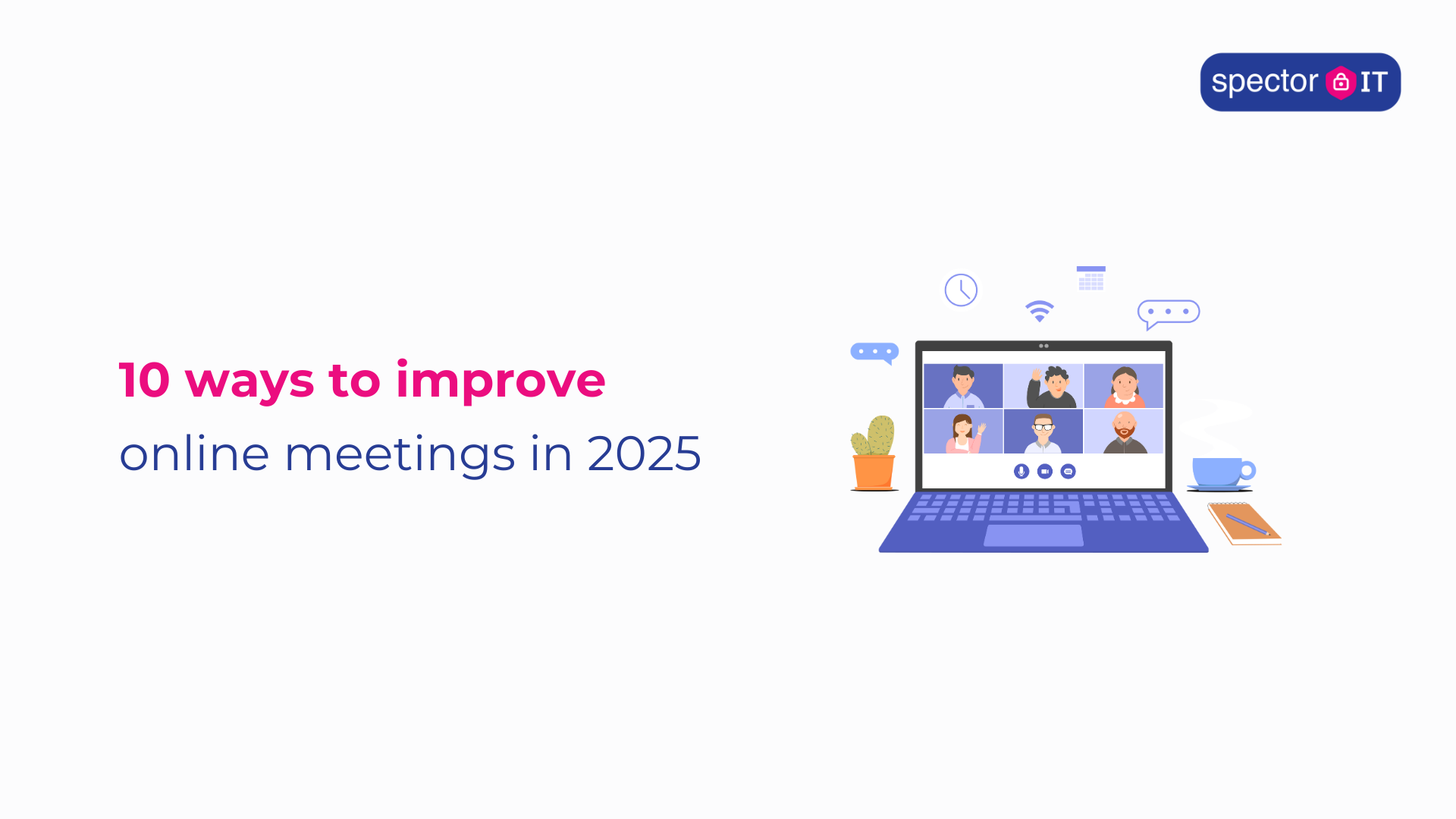
10 Ways to Improve Online Meetings in 2025
We’ve all sat through awkward, directionless, or overly long online meetings. For senior decision-makers, poor virtual collaboration isn’t just frustrating—it’s expensive. If your team spends 20% of its week in meetings, then learning to improve online meetings can directly boost productivity and morale.
This article shares 10 hands-on tips we use at Spector IT to run focused, effective, and human-centred online meetings—with clients and internally. We’ve based this on lessons from real-life experience and best practices from sources like Microsoft Teams and Harvard Business Review.
10 Proven Ways to Improve Online Meetings
1. Start with the Right Platform (And Make It Your Own)
Zoom, Microsoft Teams, Google Meet—they’re all solid. What matters is how your business uses them. Are all participants familiar with the key features? Does everyone know how to mute/unmute, change backgrounds, or share a screen?
Tip: Use branded meeting backgrounds, enable lobby entry rules for client calls, and run a 2-minute tech check before new client sessions.
Read our Microsoft Teams deployment guide.
2. Open With Purpose and People, Not Slides
Set the tone by starting with something personal and relevant:
-
Mention good news (new client win, team achievement, shout-out).
-
Briefly outline the meeting’s goals and format.
-
Ask a light check-in question: “What’s one thing you’re looking forward to this week?”
This humanises your meeting and boosts engagement right from the start.
3. Use Video—But Respect Zoom Fatigue
Yes, video is valuable. It fosters connection and accountability. But no, it shouldn’t be forced. Give people clear expectations (“Cameras on for check-ins and discussion”), and allow breaks during longer calls. Consider audio-first days where possible.
4. Stick to a Clear Agenda with Real-Time Notes
An agenda shared 24 hours ahead helps attendees prepare. We recommend using tools like Microsoft Loop, OneNote, or even a shared Word doc with:
-
Agenda bullets
-
Live note-taking
-
Action tracking in real time
Tip: Assign a timekeeper to each call to keep things moving.
5. Make Your Meetings Shorter (and Smarter)
Aim for:
-
15–30 minutes for daily/weekly syncs
-
45–60 minutes max for strategic or planning sessions
End five minutes early when possible. It gives people a mental breather before their next call.
6. Share Visuals & Links Effectively
Don’t read slides. Instead:
-
Share your screen only when needed
-
Use annotated documents or live demos to illustrate your point
-
Paste relevant links in the chat (e.g. to a SharePoint folder)
This supports different learning styles and keeps everyone “on the same page”.
7. Actively Involve Every Attendee
In group calls, participation can be skewed. As a host:
-
Ask open-ended questions.
-
Use the “round-robin” format (everyone gets 60 seconds).
-
Involve quieter team members early—especially when discussing sensitive or cross-functional topics.
Tip: For larger calls, use breakout rooms to increase engagement.
8. Capture Actions With Owners and Deadlines
Use the last 5 minutes of every meeting to review:
-
Key decisions
-
Action items
-
Who owns what and by when
9. Schedule (and Stick to) Recurring Cadence
Don’t leave scheduling to chance. For internal teams:
-
Pick a fixed time every week
-
Avoid last-minute reschedules
-
Block calendar time in advance
For client calls, always set the next date before the current call ends. It saves time and sets expectations.
10. Score and Improve Every Meeting
At wrap-up, ask attendees to rate the session anonymously in chat. Anything < 8 demands a quick debrief on what to fix, helping you continuously improve online meetings over time.
What’s New in 2025?
- AI meeting summaries (Teams Premium) – Automatic notes and action extraction save 20 min per participant.
- Eye-contact correction – NVIDIA Maxine realigns gaze, reducing “looking-away” perception.
- Spatial audio – Zoom’s new feature separates voices, cutting cognitive load for large calls.
Common Pitfalls and How to Avoid Them
-
Over-inviting: cap attendees to decision-makers + subject experts.
-
Notification noise: set Windows Focus Assist to “Priority Only” during calls.
-
Lack of backup plan: keep a dial-in number handy in case VoIP drops.
Ready to Improve Online Meetings Across Your Organisation?
Our Modern Workplace team designs and supports cloud collaboration stacks that make meetings faster, clearer and more secure. Book a discovery call and we’ll benchmark your current setup against industry best practices.
Watch out for our handy guide to online meeting technology. If you’re looking for more useful information to better enable your business for Remote Working, make sure to check our article: The Best Tips and Guides for Remote Working. Alternatively, read Our Short Guide on how to safely Implement Remote Working.
Post updated on – 12/05/2025

